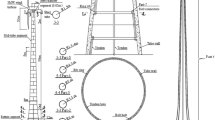Abstract
This study investigated the fatigue behaviors at the joint of a hybrid steel–concrete wind turbine tower. A fatigue design approach was proposed for the joint based on CEB-FIP model code 1990 and Eurocode 2. In addition, to estimate the long-term fatigue performance related to continuous wind changes at the joint, two types of specimens were fabricated and tested. Each specimen consisted of steel and concrete sections, which were connected with anchor bolts, and they were designed to investigate the effect of the embedded length of the anchor bolt. Two million cycles of cyclic loading were applied to the specimens, after which a monotonic static loading was applied to investigate the residual performance of each specimen. The experimental results demonstrate that the joint of a hybrid steel–concrete wind turbine tower designed using the proposed approach retained sufficient fatigue performance. Thus, this approach can be effective for fatigue design of the joint.
Similar content being viewed by others
References
Alvarez-Anton, L., Koob, M., Diaz, J., and Minnert, J. (2016). “Optimization of a hybrid tower for onshore wind turbines by building information modeling and prefabrication techniques.” Visualization in Engineering, Vol. 4, No. 1, p. 3, DOI: https://doi.org/10.1186/s40327-015-0032-4.
Bai, X., He, M., Ma, R., Huang, D., and Chen, J. (2017). “Modelling fatigue degradation of the compressive zone of concrete in onshore wind turbine foundation.” Construction and Building Materials, Vol. 132, pp. 425–437, DOI: https://doi.org/10.1016/j.conbuildmat.2016.12.026.
CEB (Comite Euro-International du Beton) (1993). CEB-FIB model code 1990, Thomas Telford service Ltd., London, England.
Delhomme, F., Debicki, G., and Chaib, Z. (2010). “Experimental behaviour of anchor bolts under pullout and relaxation tests.” Construction and Building Materials, Vol. 24, No. 3, pp. 266–274, DOI: https://doi.org/10.1016/j.conbuildmat.2009.08.038.
Delhomme, F., Thierry, R., Arrieta, B., and Limam, A. (2016). “Pullout behavior of cast-in-place headed and bonded anchors with different embedment depths.” Materials and Structures, Vol. 49, No. 5, pp. 1843–1859, DOI: https://doi.org/10.1617/s11527-015-0616-4.
EN 1992–1-1 (2004). Eurocode 2: Design of concrete structures — Part 1–1: General rules and rules for buildings, EN 1992–1-1:2004, European Committee for Standardization, Brussel, Belgium.
EN 1993–1-1 (2005). Eurocode 3: Design of steel structures — Part 1–1: General rules and rules for buildings, EN 1993–1-1:2005, European Committee for Standardization, Brussel, Belgium.
EWEA (The European Wind Energy Association) (2009). The economics of wind energy, European Wind Energy Association, Brussels, Belgium.
GL (Germanischer Lioyd) (2010). Rules and guidelines IV industrial services. Part 1: Guideline for certification of wind turbines, Germanischer LIoyd Inderstial Service GmbH, Hamburg, Germany.
GWEC (Global Wind Energy Council) (2016). “Global wind report 2016.” http://gwec.net/publications/global-wind-report-2/global-windreport-2016/ [Accessed on August 12, 2017].
Hariyadi, Munemoto, S. and Sonoda, Y. (2017). “Experimental analysis of anchor bolt in concrete under the pull-out loading.” Procedia Engineering, Vol. 171, pp. 926–933, DOI: https://doi.org/10.1016/j.proeng.2017.01.391.
KCI (Korea Concrete Institute) (2012). Korea structural concrete design code and commentary, Korea Concrete Institute, Seoul, Korea.
Petersen, C. (1998). “Fatigue assessment eccentrically loaded ring flanges.” Stahlbau, Vol. 67, No. 3, pp. 191–203.
Rodriguez, M., Lotze, D., Gross, J. H., Zhang, Y. G., Klingner, R. E., and Graves, H. L. (2001). “Dynamic behavior of tensile anchors to concrete.” ACI Structural Journal, Vol. 98, No. 4, pp. 511–524.
Schmidt, H. and Neuper, M. (1997). “Elastic-static behaviour of eccentrically tensioned L-connections with pre-stressed bolts.” Stahlbau, Vol. 66, No. 3, pp. 163–168.
Staffan, E., Lyrner, T., Hassanzadeh, M., Stalin, T., and Johansson, J. (2010). Tall tower for large wind turbines, Repot No. 10:48, Swedish Electricity Company Research and Development, Stockholm, Sweden.
Von der Haar, C. and Marx, S. (2015). “Design aspects of concrete towers for wind turbines.” Journal of the South African Institution of Civil Engineering, Vol. 57, No. 4, pp. 30–37, DOI: https://doi.org/10.17159/2309-8775/2015/v57n4a4.
Acknowledgements
This study was supported by Korean Institute of Energy Technology Evaluation and Planning (KETEP) granted financial resource from the Ministry of Trade, Industry & Energy, Republic of Korea (No. 20123010020060).
Author information
Authors and Affiliations
Corresponding author
Rights and permissions
About this article
Cite this article
Kim, M.O., Kim, T.M., Lee, D.Y. et al. Experimental Investigation of the Steel-Concrete Joint in a Hybrid Tower for a Wind Turbine under Fatigue Loading. KSCE J Civ Eng 23, 2971–2982 (2019). https://doi.org/10.1007/s12205-019-1171-2
Received:
Revised:
Accepted:
Published:
Issue Date:
DOI: https://doi.org/10.1007/s12205-019-1171-2




